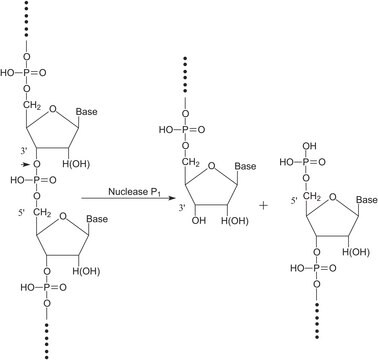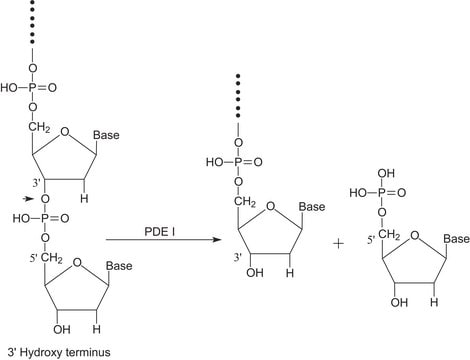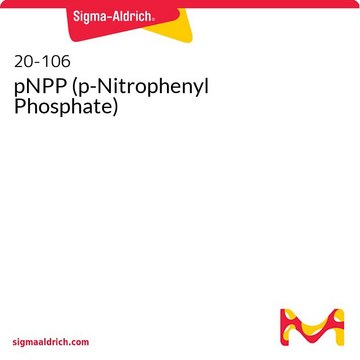P4252
Phosphatase, Alkaline from Escherichia coli
ammonium sulfate suspension, 30-90 units/mg protein (modified Warburg-Christian, in glycine buffer)
Synonym(s):
Orthophosphoric-monoester phosphohydrolase (alkaline optimum)
Sign Into View Organizational & Contract Pricing
All Photos(1)
About This Item
Recommended Products
biological source
Escherichia coli
Quality Level
form
ammonium sulfate suspension
specific activity
30-90 units/mg protein (modified Warburg-Christian, in glycine buffer)
storage temp.
2-8°C
Looking for similar products? Visit Product Comparison Guide
Related Categories
Application
Alkaline phosphatase is used for conjugation to antibodies and other proteins for ELISA, Western blotting, and histochemical detection. It may be used for protein labeling when high sensitivity is required. Product P4252 has been used for bulk digestion of tRNA . Product P4252 is provided in the ratio of 30-90 units/mg of protein.
Alkaline phosphatase is used for conjugation to antibodies and other proteins for ELISA, Western blotting, and histochemical detection. It may be used for protein labeling when high sensitivity is required. Product P4252 is an ammonium sulfate suspension in glycine buffer.
Biochem/physiol Actions
Alkaline phosphatase, from Escherichia coli, is a dimeric, non-glycosylated protein which mainly reside in the periplasmic space. Three known isoforms exist. The enzyme requires zinc, and is activated by magnesium. E. coli akaline phosphatase has a broad specificity for phosphate esters.
Alkaline phosphatase, from Escherichia coli, is a dimeric, non-glycosylated protein which mainly reside in the periplasmic space. Three known isoforms exist. The enzyme requires zinc, and is activated by magnesium. E. coli akaline phosphatase has a broad specificity for phosphate esters.
Caution
Presence of 0.1% SDS in the alkaline phosphatase assays will inhibit any nuclease contamination in the sample.
Unit Definition
One unit will hydrolyze 1.0 μmole of p-nitrophenyl phosphate per min at pH 10.4 at 37 °C.
Physical form
Suspension in 2.5 M (NH4)2SO4
Analysis Note
The activity at pH 8.0 at 25 °C is approximately the same as at pH 10.4 at 37 °C.
inhibitor
Product No.
Description
Pricing
Signal Word
Danger
Hazard Statements
Precautionary Statements
Hazard Classifications
Resp. Sens. 1
Storage Class Code
11 - Combustible Solids
WGK
WGK 1
Flash Point(F)
Not applicable
Flash Point(C)
Not applicable
Personal Protective Equipment
dust mask type N95 (US), Eyeshields, Gloves
Choose from one of the most recent versions:
Already Own This Product?
Find documentation for the products that you have recently purchased in the Document Library.
Customers Also Viewed
The universal YrdC/Sua5 family is required for the formation of threonylcarbamoyladenosine in tRNA
Basma El Yacoubi, Benjamin Lyons, et al.
RNA, 37, 2894-2909 (2009)
E. coli Alkaline Phosphatase
1.Reid, T., and Wilson
The Enzymes, 4, 373-373 (1971)
Alkaline phosphatase from Thermotoga neapolitana.
A Savchenko et al.
Methods in enzymology, 331, 298-305 (2001-03-27)
R A Anderson et al.
Proceedings of the National Academy of Sciences of the United States of America, 72(1), 394-397 (1975-01-01)
To facilitate the study of individual metal binding sites of polymeric metalloproteins, conversion of exchange-labile Co(II) in E. coli alkaline phosphatase (EC 3.1.3.1) to exchange-inert Co(III) was examined. Oxidation of Co(II) alkaline phosphatase with hydrogen peroxide results in a single
Yufang Xu et al.
Nature communications, 11(1), 5441-5441 (2020-10-30)
With global warming and climate change, breeding crop plants tolerant to high-temperature stress is of immense significance. tRNA 2-thiolation is a highly conserved form of tRNA modification among living organisms. Here, we report the identification of SLG1 (Slender Guy 1)
Articles
Instructions for working with enzymes supplied as ammonium sulfate suspensions
Our team of scientists has experience in all areas of research including Life Science, Material Science, Chemical Synthesis, Chromatography, Analytical and many others.
Contact Technical Service







